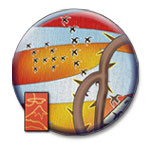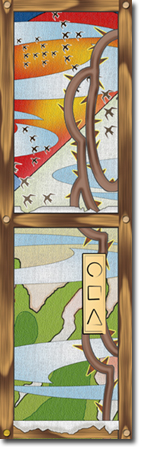On The Way: The Daily Zen Journal
Dhammacakkappavattana Sutta – The First Sermon at Benares
Thus have I heard: at one time the Buddha dwelt at Benares at Isipatana in the Deer Park. There, he addressed the five monks:
There are these two extremes that are not to be indulged in by one who has gone forth. Which two? That which is devoted to sensual pleasure with reference to sensual objects: base, vulgar, common, ignoble, unprofitable; and that which is devoted to self-affliction: painful, ignoble, unprofitable. Avoiding both of these extremes, the Middle Way, realized by the Tathagata — producing vision, producing knowledge — leads to calm, to direct knowledge, to self-awakening, to Unbinding.
Avoiding these two extremes, the Tathagata has gained the enlightenment of the Middle Path, which produces insight and knowledge, and tends to calm, to higher knowledge, enlightenment, and Nirvana.
And what, monks, is the Middle Path, of which the Tathagata has gained enlightenment, which produces insight and knowledge and tends to calm, to higher knowledge and Nirvana? This is the noble Eightfold Way: namely, right view, right intention, right speech, right action, right livelihood, right effort, right mindfulness, right concentration. This is the Middle Way awakened to by the One Who Moves in Reality, which gives rise to knowledge which leads to peace, to higher knowledge, to full awakening.
Now this, monks, is the noble truth of pain: birth is painful, aging is painful, illness is painful, death is painful; sorrow, lamentation, physical pain, unhappiness and distress are painful; union with what is disliked is painful; separating from what is liked is painful; not to get what one wants is painful; in brief, the five bundles of grasping are painful.
Now this, monks is the noble truth of the cause of pain: it is this craving which leads to renewed existence, accompanied by delight and attachment, seeking delight now here, now there; that is, craving for sense pleasures, craving for existence, craving for the ending of what is not liked. 
Now this, monks, is the noble truth of the cessation of pain: it is the remainderless fading away and cessation of that same craving, the giving up and relinquishing of it, freedom from it, non-reliance on it.
Now this, monks, is the noble truth of the way that leads to the cessation of pain: this is the noble Eightfold Path, that is to say, right view, right resolve, right speech, right action, right livelihood, right effort, right mindfulness, right mental concentration.
This is the noble truth of pain. Thus, monks, among doctrines unheard before, there arose vision, knowledge, wisdom, and light. This noble truth of pain must be comprehended.
So long, monks, as my knowledge and seeing of these Four Realities of the Noble Truths was not thoroughly purified in this way, then I did not claim to be fully awakened to the unsurpassed perfect awakening. But when, monks, my knowledge and vision of these Four Realities were purified in this way, then I claimed to be fully awakened. Indeed, knowledge and seeing arose in me. Unshakeable is the liberation of the mind; this is my last birth: now there is no more renewed existence.
Buddha’s first sermon
Excerpted from Early Buddhist Scriptures E. J. Thomas 1935





Many times we have read or heard the stories of Buddha’s life and enlightenment. Returning to his first teaching upon awakening, we come in contact with the ground and source of Buddhism. The root from which the many branches developed over the years that followed. We are never so far along the path of practice that these beginning words lose their power to move us. Imagine being in that group of five monks who had practiced austerities with Buddha before his enlightenment and hearing the fruits of his meditation?
The Four Noble Truths embody an awareness that is active every moment of every day. We watch craving or desire arise, and without practice or training, we are acting on these thoughts that arise moment to moment. With meditation, there is the possibility of a pause that can enable us to step back and observe and choose not to follow impulses that create more karma.
Imagine a line of dominoes stacked on end next to each other in a long chain; if you touch the first one, the chain reaction continues until the line is exhausted. Sometimes going through life can feel like that…now imagine taking out 2 or 3 dominoes, and the process stops long enough to choose whether the direction is truly one that is beneficial.
Here, in what appears to be the simplest teaching, is the heart of practice, the sword of awareness that never dulls.
With Enthusiasm,
Elana, Scribe for Daily Zen